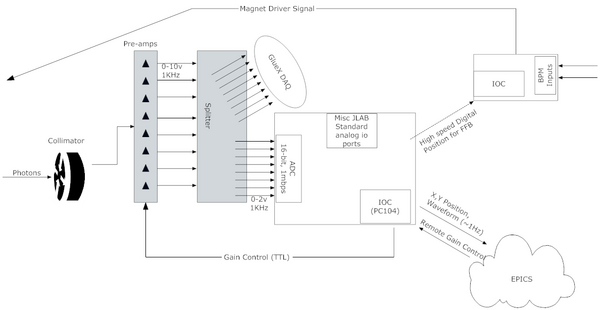CollimatorMtgs-2-4-2013
Hall D Collimator Meeting Minutes (Tuesday, Feb 5, 2013)
Minutes courtesy of Theo Larrieu
Attendance
- University of Connecticut: Richard Jones, James McIntyre
- Jefferson Lab: Theo Larrieu, Alexander Somov, Igor Senderovich, Hovanes Egiyan, Pete Francis, John Musson, Trent Allison, Brian Bevins, Scott Higgins
Topics
Discussion of the specifications for interfacing the Active collimator to the accelerator control system and to the Hall D Data Acquisition System. The accompanying figure and the notes below summarize.
(Note: The figure is based on the whiteboard drawing John made during the first half of the meeting before we had to switch meeting rooms. I revised John's sketch based on my understanding of the ensuing discussion. If I have mis-represented something, please let me know and I will issue a revision. Ultimately I expect that John and Trent will provide an accurate schematic with their design proposal to take the place of this cartoon.)
Verbal Description of diagram
The signal from the 8 positional detectors (4 quadrants, inner & outer) will feed to 8 pre-amplifiers which will be supplied by Hall D.
From the preamps, an approximately 12-14 meter cable run will feed into a splitter/conditioner board. One set of outputs from the splitter will run to the Hall D counting house for data acquisition and/or raw diagnostics purposes while the second set will run to an ADC inside a JLAB electronics chassis that contains a PC104 IOC, and various standard diagnostic analog I/O ports.
That IOC will implement the algorithm (to be provided by Richard -- see action items) to convert the 8 digitized collimator readouts into X and Y beam center coordinates which it will write out to EPICS process variables, along with a 4000 point waveform record 1/second. The IOC will have outputs cabled back to the preamps, thereby allowing for remote gain control from EPICS.
The illustration shows a hypothetical second IOC that would be receive low latency position updates over fiber optic cable from the collimator system which combined with as yet undetermined BPM inputs would drive the correctors for a fast feedback system. The specifications for this feedback system await clarification.
Notes
The issue was raised of whether an auto-gain implementation was desired for the pre-amplifiers and Richard indicated that it was not practical because changing the gain will require changes to offsets and a rezeroing. As such changes to gain will need be a manual process.
It is envisioned that after commissioning, MCC operators will manage the gain setting as a matter of course. When the need arises for Hall D personnel to assume responsibility for doing so, it should be possible for them to call the control room and have the operators grant them the necessary access.
There was discussion of whether single-ended TTL would suffice for the cabling between the preamps and the control chassis. Richard indicated that for testing performed earlier in Hall B (~10m), single-ended worked just fine.
John believes it's likely that a standalone splitter/conditioner board to feed the raw signal simultaneously to the control system chassis and to the Hall D Daq can be purchased "off-the-shelf" at modest cost. Doing so removes the need for having a DAC inside the chassis to send analog outputs to Hall D Daq and also means that the Hall D Daq will not be dependent upon the controls system hardware.
Also discussed was whether the algorithm to convert collimator readout signals into positions would be implemented in software on the IOC or by an FPGA. Ultimately it will depend on the details of the algorithm and the performance when it is implemented. A software implementation on the IOC will be more flexible and easier to maintain, but if that cannot meet performance requirements, the Engineers should have the capability to implement it in an FPGA. It is too early to decide at this point.
Action Items
- Richard will supply the algorithm for converting the symmetry of the collimator into X and Y positions. Providing it in the form of the equations or pseudo-code will suffice. No need to code it in C or HDL right now b/c unclear where it will be executed at present.
- Trent will revise and fill-in-the-blanks still on the specification page at Active Collimator Interface Specification
- Bullet point 4 should be revised to remove the confusing fine/coarse terminology.
- Bullet point 8 can go away because the plan is to feed original analog signal to Hall D from the splitter
- Bullets 5,6,9,10,11 question marks need addressing
- Trent and John will provide a design proposal including hardware and manpower cost estimates for the discussed system (the stuff to the right of the pre-amps). This should be provided ASAP as there will be a 12GeV project rebaselining at the beginning of March and that will be a good time to try and incorporate the costs.
